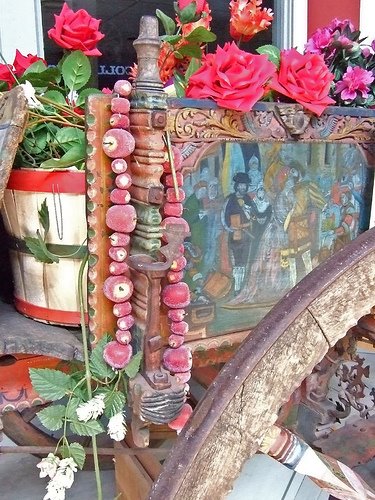 The symbol dates back to when Sicily was part of Magna Graecia. People attribute the origin of the Trinacria, to the triangular form of the island, which consists of three large capes equidistant from each other, pointing in their respective directions, the names of which were Pelorus, Pachynus and Lilybaeum.
The symbol dates back to when Sicily was part of Magna Graecia. People attribute the origin of the Trinacria, to the triangular form of the island, which consists of three large capes equidistant from each other, pointing in their respective directions, the names of which were Pelorus, Pachynus and Lilybaeum. But for a symbol that must be older than any cartographic conception of the island, there are surely other interpretations, since this symbol is associated with a multitude of triads.
While the greeks called it Triskele, The Celtics called it Triskelion and the Romans Trinacrium, meaning "star with 3 points", other Spiral forms of Trinacria are often classed as solar symbols ; supposedly Pagans. Since earliest ages, the concept of the Great Goddess was a trinity and the model for all subsequent trinities, female, male or mixed. The Goddess Triformis ruled heaven as Virgin, earth as Mother, and the underworld as Crone, or Hel, or Queen of the Shades. This was remembered even in Chaucer’s time, for his Palamon invoked her “Three Forms,” Luna in heaven, Diana on earth, Proserpine in hell. (See, Chaucer, The Canterbury Tales at 81, 511). The old name of Sicily, Trinacria, invoked her as a “centre of the earth” with three realms. Besides, the Trinacria is quite similar to the three-legged heraldic symbol of the Isle of Man, another medieval Norman dominion, but all pagan religions were soon stomped out by the rise of Christianity, and today the official history of Sicilian Trinacria is only to be attributed to Greek legends.
The head in the centre of today's Triacria was that of Medusa, whose hair was turned into snakes by the outraged goddess Athene. In their wisdom, the Sicilian parliament, which uses the Trinacria as its Flag, replaced the Medusa head with one that is less threatening to the innocent onlooker who, after all, should not be anticipating being turned to stone....







Oh, I like that. Blame it on the Greeks! I have a trinacria displayed in my home and the symbol will one day become my first tattoo. If it symbolises Paganism, then so mote it be :) (I adore your blog)
ReplyDeleteBlessings
Moana
It is a definitely a very interesting symbol Moana, and like many things in Europe, stems from the Greek civilisation.
ReplyDeleteI do have it as a tattoo, although it was my second tattoo.
ReplyDelete